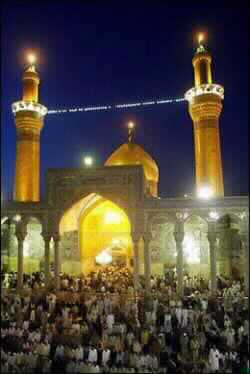Swaying and chanting, some bleeding from self-inflicted wounds of ritual mourning, an estimated 1 million Shiite Muslims marched to Karbala's Imam Hussein's Mosque. The large turnout for the annual festival, banned under Saddam, which ends Thursday, highlighted the power and potential of Iraq's majority Shiite community. Despite bitter internal differences the Shiites, who represent 60 percent of Iraq's 24 million people, were able to pull off the event on short notice and thus far without violence.
It showed how once again, upheaval in a Middle East country has brought followers of the Shiite branch of Islam to the forefront. It happened in 1979 when Ayatollah Ruhollah Khomeini founded a Shiite theocracy in neighboring Iran, and three years later when Israel invaded Lebanon, drove out Yasser Arafat and ended up facing the Shiite fighters of Hezbollah.
Faithful Shiites, many with heads bleeding and limping from long journeys in 90-degree heat, pressed up against each other on roads. U.S. troops were largely out of sight, with a few members of the U.S.-backed Iraqi National Congress at checkpoints.
The collapse of Saddam's rule left a political vacuum, "So we moved in a specialized and organized way to face this problem," said a Shiite official, Sheik Sadeq Jaafar al-Tarfi.
"All the religious leaders, Sistani and Sadr, united to make it successful and had it not been for this unity it would have failed," he said, referring to Ali Hussein al-Sistani, Iraq's top Shiite religious authority, and Muqtada al-Sadr, the son of al-Sistani's slain predecessor.
He said the Hawza al-Ilmiya, a center of Shiite learning headed by Sistani in the revered Shiite city of Najaf, sent in thousands of volunteers to manage security and traffic. American troops were ready with food and water; it wasn't needed.
But Maj. James M. Bozeman, a civil affairs officer attached to the 82nd Airborne Division, said U.S. Special Forces treated scores of Shiites for sprains, cramps and heat exhaustion.
In addition, the U.S. military said police on Monday arrested six men who had been planning to blow up two of Karbala's mosques. Five of the detainees claimed to be members of Saddam's Baath Party, and one said he belonged to al-Qaida, said Army Capt. Jimmie Cummings.
The United States hopes to work with Shiites to form a new government without resorting to a Shiite theocracy like Iran's - a balancing act that will test the skills of retired U.S. Lt. Gen. Jay Garner, who is overseeing Iraq's postwar reconstruction.
Since Saddam fell, Shiites have been setting up local administrations, and religious leaders have emerged as key sources of political power, especially in southern Iraq. It is unclear whether religious leaders will be ready to transfer power to a new government.
Senior Shiite religious leaders insist they want to share power with Iraq's other communities, particularly Sunnis and Kurds. But many Shiites - from secularists to fundamentalists - have also shown a deep mistrust of U.S. efforts in Iraq.
There was anti-American sentiment among the faithful Tuesday. Some held signs that said, "Bush equals Saddam" and "Down USA."
Shiites from Iran joined those from Iraq and other countries to converge on Karbala - site of the 7th-century martyrdom of Hussein, (May Allah Be Pleased with Him) a grandson of the Prophet Muhammad [PBUH]. The extent of the Iranian presence was unclear. The border between the two countries is officially closed but porous.
Akram al-Hakim, a London-based Iraqi Shiite activist, said outsiders who expect Iraqi Shiites to try to recreate Iran's clerical regime have "Iran phobia."
"Iraqi Shiites cannot contemplate an Islamic state to replace Saddam's regime. They only want their share of power," he said.
Even so, some Shiites said Iran is a model.
The festival marks the anniversary of the end of the traditional 40-day mourning period for Imam Hussein [MABPH], who died because the people failed to rise up and support him in the face of a vast army.
The main mosque in Karbala is Imam Hussein's tomb, but other Shiite religious leaders are buried there, and their graves attract visitors, too.
At one of the entrances to Karbala, members of the Free Iraqi Forces, the military wing of the U.S.-backed Iraqi National Congress, were seen checking cars. Some wore black headbands, a symbol of mourning.
Brig. Gen. Vincent Brooks, deputy operations director at U.S. Central Command, noted it was the U.S.-led overthrow of Saddam that made the festival possible.
PHOTO CAPTION
Iraqi Shiites are gathered at the Imam Hussein mosque in Karbala, central Iraq, as thousands converged onto the Shiite-revered city to commemorate the death of Imam Hussein, [MABPH] who was beheaded at the site in 680 A.D. (AFP/Karim Sahib)
- Author:
& News Agencies - Section:
WORLD HEADLINES


 Home
Home Discover Islam
Discover Islam Quran Recitations
Quran Recitations Lectures
Lectures
 Fatwa
Fatwa Articles
Articles Fiqh
Fiqh E-Books
E-Books Boys & Girls
Boys & Girls  Articles
Articles










